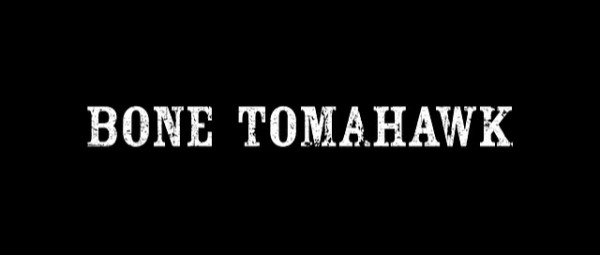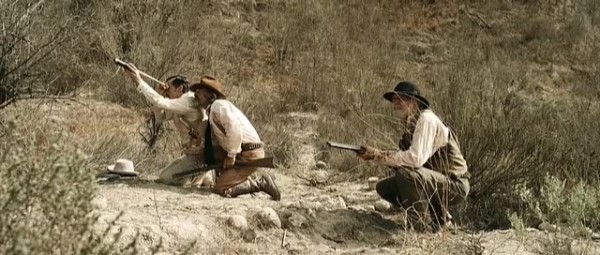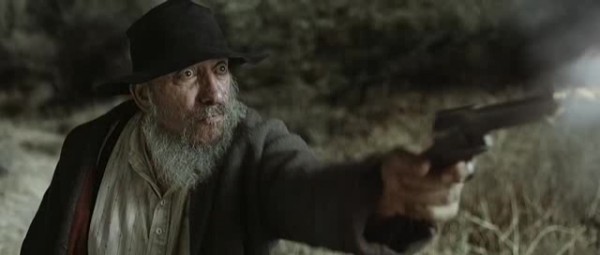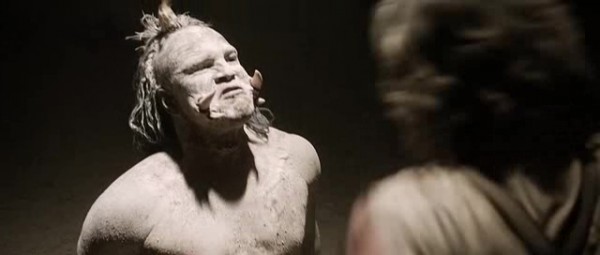
For genre-film nerds like myself, Bone Tomahawk seems like it’s too good to be true. A gritty ultra violent western with a killer cast led by Kurt Russell, featuring a play on The Searchers with cannibal caveman? I daydream about movies like that! Unfortunately an untested director, a crazy-short shooting schedule, small budget, and numerous false-starts on production promised a movie that would be, at best, an endearing disaster and at worst an under-cooked pretentious slog. I have never been so happy to be wrong.
Our story concerns four men on the search for a tribe of cannibal troglodytes who have taken a deputy, a woman, and a prisoner from the town of Bright Hope in the night.
Sheriff Hunt (Kurt Russell) is the de-facto leader of the group. He’s a no-nonsense figure; all swagger and bravery, but still valorous and kind. Hunt is a John Wayne archetype and Kurt Russell plays it to a tee. While Kurt Russell is, as always, great in his role he gives the weakest performance of the lead actors. This is through no fault of his own, he’s just a great actor playing against three other leads who are giving some of the best performances of their career.
Arthur O’Dwyer (Patrick Wilson) is the husband of the woman who was taken. At the beginning of the film Arthur is lain-up at home with a broken leg from an attempt to patch the roof in a storm. When his wife Samantha (Lili Simmons) is taken he plans to go with the party to rescue her and refreshingly there is no argument between he and the sheriff about it. Midway through the movie the group lose their horses and they’re forced to go on foot, Arthur ends up trailing behind due to his injured (and re-injured, numerous times) leg. This confines the character to the background for a good chunk of the movie, it’s certainly a less flashy role than Patrick Wilson’s three co-stars and many are quick to dismiss his performance as merely adequate. The thing is, I’ve seen endless movies with endless Arthur O’Dwyers and I can assure that Patrick Wilson is as talented as he ever was, he just has a rather thankless part to play.
I don’t remember if I was upset whenever Timothy Oliphant backed out of this movie, but I’m sure I was. And if I was upset at Oliphant’s departure I was likely even more incensed by the hiring of Matthew Fox in his place. If so, I couldn’t have been more wrong. Matthew Fox has an extremely limited range as an actor but John Brooder is the role he was born to play. Emotionally unavailable and aloof, it would be easy for Brooder to be a simple ripoff of Doc Holliday from Tombstone, but Fox plays his friendly sociopath with just enough emotion to make those moments when his icy veneer drops particularly effective.
Chicory (Richard Jenkins) is Hunt’s back-up deputy (likely just an honorary title to give a lonely and bothersome old man something to do.) Chicory likes to talk incessantly about a myriad of ridiculous things, often at completely inconvenient and inappropriate times but he’s loyal and competent in his own way for a naive idiot well past his physical prime. Chicory is the film’s primary source of comedic relief and gets off as many great funny bits at the expense of others as he does at himself. The character is the heart of the movie and engenders the film’s core theme of hope, both its downfalls and triumphs. Easily the best character dynamic in the film is between Hunt and Chicory as the Sheriff shows a kindness and gentle patience for this old man who is really almost more of a burden than a boon to him. No exaggeration, Richard Jenkins deserves at least an Oscar nomination for this performance. He won’t get it, but he deserves it.
Now, let’s talk about the troglodytes. Our murderous villains are a hot button issue for one key reason, they are technically Native Americans. After the attack on the town, Sheriff Hunt calls in “The Professor” who turns out to be a Native named Tall Trees (Zahn McClarnon) who explains that the trogs are technically Native Americans due to simply being a race of human beings that were alive in the Americas at the same time as all the other tribes, but that they’re a sour bloodline of incestuous rapist cannibals that doesn’t even have its own language.
This moment has been mentioned in every single review of this film I have seen thus far, most seem to see it as a half-assed apology whilst still pursuing the mindless savage portrayal of indigenous people that persists to this day. Here’s the thing: Leatherface and the Sawyer family aren’t representatives of the average Texans and the amount of white people who behave like Papa Jupiter and his murderous family of desert cannibals is a staggeringly small number. The only reason this moment is a big deal is because of the pervading stereotype of the “Savage Indian” that poisons American culture due to the fact that our European ancestors were genocidal assholes.
I’ve heard people say a Native American should’ve joined them on the hunt (they ask Tall Trees to show them where the trogs live and he tells them he’s not stupid enough to go messing with them) or that they should’ve gone a more realistic approach with an actual tribe that had turned to cannibalism (because, like fire, it’s best to approach touchy subject matter by charging right through it at top speed I guess.) The trogs are as much Indians as the crawlers from The Descent, they’re just a little further down the evolutionary chain to where they know how to make fire and weaponry and use camouflage. While Tall Trees’ speech does stick out like a sore thumb, it unfortunately has to be stated that the shrieking violent cavemen aren’t representative of Native Americans because people are awful.

Bone Tomahawk was written and directed by S. Craig Zahler; Zahler is a novelist who has written a couple of pulpy dark western/horror stories and that certainly explains a lot about this movie. Bone Tomahawk has a very literary style of storytelling in the way that action happens and the way in which characters have a more naturalistic style of speaking with intermittent pauses and asides. A simple scene near the beginning of the movie where Chicory comes in and tells Hunt about a suspicious character in town turns into a slow rambling conversation between the two men that reveals volumes about who these characters are and what they are to each other that would’ve been cheapened to just a simple delivery of information in most movies.
This style is used to great effect in the polarizing second act of the film where our four men wander through the desert for nearly an hour with very little happening. Some reviewers found this section bloated and interminable but a good western needs room to breathe and even when nothing is happening in Bone Tomahawk, something is always happening. From the first frame a pervading sense of doom creeps into the movie. Tall Trees’ moment of exposition may seem clumsy, but without it we wouldn’t know what the characters are in for and it’s that expectation of brutality to come that makes this dread build as the film goes on.
If you’re a long-time fan of horror movies you may look at our four leads and see that each and every one of them comfortably fits into the archetype of “first character to die.” Will it be the overconfident hero? The good-hearted idiot? The cocky gunfighter? The injured, stubborn lover? Is there any chance that any of these men will survive? It’s the expectation that our heroes, none of whom are emotionally expendable, are riding into certain death which builds up the tension, and the second act makes sure that we know who all these men are, that we get to know them and love them so we’re extra concerned for their well-being when things go to Hell. And things definitely go to Hell.
When this movie shifts from dark western with tinges of horror to horror with tinges of a dark western, it does so as quickly and brutally as an axe to the face. The first attack is disorienting and confusing and what follows is painful and ugly, yet still manages to find time for a sly sort of humor and tenderness evoking various literary soulmates such as Charles Portis’ True Grit, Alan LeMay’s The Searchers and The Unforgiven, William Dale Jennings’ The Cowboys, Cormac McCarthy’s Blood Meridian, as well as various works by authors such as Larry McMurtry, William Faulkner, and Ambrose Bierce.
At the heart of all things, while Bone Tomahawk may have passing similarities to things like Dead Birds, The Burrowers (which would make a great double feature with this), Ravenous, Brotherhood of the Wolf, The Missing, and Ginger Snaps 3 it is written more in the style of a traditional (admittedly very dark) western. The world our characters live in is brutal on its own, the trogs are just terrible frosting on the cake that is life on the frontier and that’s where our movie’s two main themes come into play.
Our first theme is hope, the town the characters are from is called Bright Hope, Chicory’s speeches are all optimistic talking about how he believes that flea circuses are real and how when they all get back he’s going to buy a music stand so he can read books in the bath without ruining them. While there are times that the movie shows the merits of hope, it generally comes down on the side that hope is for fools. Mere moments after a character has explained to Chicory the reason why he promised a dying man that the cavalry is coming when it wasn’t, he shouts out “I’ll avenge you” as that same character is being brutalized by cannibals.
And that brings us to our other theme, foolish bravado. A character dresses down Hunt near the end of the movie, completely deflating the heroic image of the man that the film has built up to that point. They reveal how stupid his plan was, how he charged into the situation without proper preparation and planning and all that he’s managed to do is to get more people killed and nobody saved. It makes the character seem childish and small and that same feeling extends to all the other leads. Destroying the romanticism of the western is nothing new, but destroying the romanticism of doing everything you can to help someone you care for is a particularly bitter pill to swallow.

Now let’s talk about the technical side of things. This is where Bone Tomahawk’s limited budget and short shooting schedule become the most apparent. First there’s the set design, or rather there isn’t. Bright Hope doesn’t look like anyone lives there or ever has, the trogs’ cave is clearly built on a sound stage and features almost no decoration or signs of life. It’s obviously just a big room with a hallway that leads to nowhere. Fortunately the lion’s share of this movie takes place outside where Mother Nature has spared no expense in decorating the sets, but when people are inside of a place it is distractingly apparent that there was no time and/or money for set design.
I could pick apart the film for it’s general cutting of corners (for example most of the action scenes are just gunfights with very little bullet impact and we only ever see three trogs at a time, I was actually shocked to find that twelve were actually cast since I wouldn’t have noticed if they just reused the same three people over again) but I actually kind of appreciated the minimalist approach to the film. I recognize a budget saving measure when I see one, but when it’s done economically like it is here I’m more impressed than annoyed.
The cinematography is the biggest point of contention for a lot of people and I get where they’re coming from. We don’t really see the trogs, we don’t really see the landscape, there’s no sense of geography and as far as the viewer is concerned the entire movie could be taking place on the same hundred-yard plot of land rather than the several days ride it is purported to be. The scenes of violence are jerky and confusing, the gore effects are viewed from a distance and you don’t get a lot of close-ups or iconic shots as a result. Many have excused this as being a result of the hurried pace with which this movie was completed and that’s a perfectly reasonable explanation, though I’m willing to give the filmmakers the benefit of the doubt. What’s important to me is that, intentional or not, the cinematography works.
The passive camera makes the audience feel less like an omniscient floating eye capable of going up close or miles away in a blink as we normally do, and more like a person standing around with the characters. We’re a ground level observer and we experience the confusion, the disorientation, the view with the characters. The only reason I think this might have been intentional is that the focus that the shots use feels very similar to the 3rd person perspective of most novels, it’s a very literary film sensibility. The audience is a fifth party member that the characters ignore and it makes the movie feel claustrophobic and tense, we feel the sense of vulnerability with our characters as the trogs only pop up when one of our leads see them and remain an unseen but felt menace the rest of the time. This kind of cinematography isn’t the best for a western but it’s great for a horror movie and certainly contributes to Bone Tomahawk actually being scary.

Ultimately I think Bone Tomahawk is written too much like a western for horror fans and shot too much like a horror movie for western fans. Similarly the horror crowd will find its slow-burn narrative boring whilst the western crowd will dislike the gory third act. This is a movie for a very particular niche of fans and for those people I promise you that this is the very best movie of its kind out there. Believe the hype, this is a great movie though it’s got some deep flaws that will be deal breakers for some. But those people aren’t writing this review, I am, and this movie has jumped into my most-loved category for the year. I cannot wait to own this movie and I hope that that S. Craig Zahler makes something else very soon.
Ryan’s Rating: 




Out of a Possible 5 Stars